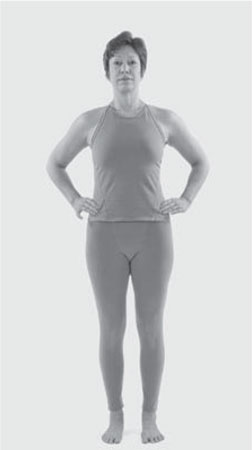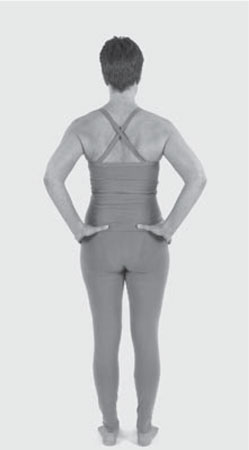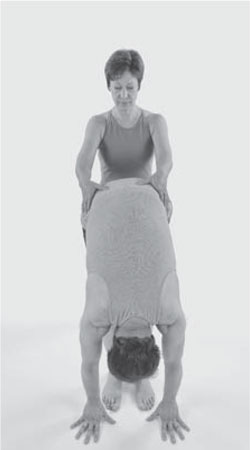Yoga for a Healthy Lower Back (5 page)
Read Yoga for a Healthy Lower Back Online
Authors: Liz Owen

Next, you'll investigate whether your PSIS, or posterior superior iliac spine, is balanced (
fig. 1.4
). These are the prominent points on the back of your hip bones. You'll need mirrors, placed so you can see the reflection of your back body, or a friend to look at your back. Stand in Mountain Pose and place your thumbs on the back of your hips. Massage the area until you find the prominent bony lines of the PSISâsometimes they are dimpled, other times they protrudeâon either side of your sacral bone. These are usually harder to find that your ASIS points, and it helps to move your trunk around so your thumbs can dig in until you feel bone rather than soft tissue. Once you've found them, your friend can assess whether they are balanced or imbalanced.

FIG. 1.3

FIG. 1.4

FIG. 1.5
Finally, a trusted friend can help you with the “Race Car Test,” a method that is taught by yoga therapeutics expert Doug Keller.
26
Have your friend stand behind you with her thumbs on your PSIS points. Come into a standing forward bend (
fig. 1.5
).
If one of your helper's thumbs goes faster and farther toward your waist than the other, like a race car driver who pulls ahead of the pack, the sacral joint on that side of you may be tighter and stuck, which “pulls” your PSIS forward.
The causesâand often the resultsâof hip bone height and rotation difference are many, including ankle pronation, weak leg musculature, leg length difference, scoliosis, muscular asymmetry, and hyperextension or inward collapse of the knee.
27
But fear notâyou'll explore yoga poses to help reestablish balance in your hip bones and sacral joints in chapters 2 and 3.
H
OW TO
S
IT
Now that you've experienced your natural alignment in a standing position, you'll discover how to create it as you sit as well. Sitting in a way that
supports lower back health isn't at all simple, and when you consider the fact that back pain is one of the most common work-related injuries and is often caused by ordinary work activities such as sitting in an office chair, it's clear that many people do not know how to sit in a way that helps their lower backs meet the demands of their workday.
28
Let's start with a quick self-evaluation exercise. Place a chair sideways to a mirror, sit in the chair with your feet flat on the floor (or on a yoga block if they don't reach), and look at your profile in the mirror. Before you make any adjustments, observe how you habitually sit. Does your lower back collapse backward, or does it overarch forward? Does your shoulder girdle sit squarely on top of your pelvic girdle, or does it shift forward or back? Are your ears in line with your shoulders with your chin parallel to the floor? Don't worry if you're “off” in your alignment; we'll work with each of these points to create a healthy seated position.
Place one hand on the front of your hips and the other on your back hips. Drop your tailbone downward while you draw your navel slightly toward your spine. If these actions sound familiar, it's because you practiced them to find neutral hip position, which is exactly what you've just done in your seated position. You should feel your lower back elongate while your abdominal wall becomes engaged and ready to help support your lower back.
Roll your shoulders back so your collarbones broaden, then draw your shoulder blades down toward your waist, without overarching your lower back. Your shoulders should drop away from your earsâthis should be a good feeling of length in your neck. Draw your shoulder blades gently toward each other and press them gently forward, imagining them as “helping hands” that support your chest and help it to open and broaden. Look at your profile once again to be sure your shoulder girdle is aligned over your hips.
Finally, draw your ears back, in line with your shoulders, to align your head over your shoulder girdle. Tuck your chin slightly, just enough to feel that your chin is parallel to the floor and the back of your neck is long. Close your eyes for a moment and feel your head effortlessly balanced on top of your spine. Visualize your spine gently curving, long, lifting, and light.
Now that you've created your natural alignment in a chair-seated position, explore it in a cross-legged floor-seated position called Sukhasana, or Easy Pose (
fig. 1.6
). If your thigh or hip muscles are tight, sitting on the floor may feel very different from sitting in a chairâand far more challenging. But it's good to work on floor sitting because it brings flexibility into your thigh and hip myofascia, gently tones your abdominal core, and stimulates circulation in your pelvis and lower abdomen.

FIG. 1.6
Sit on the floor with your legs crossed, and adjust your position with one or more of these tips:
â¢Â  If your lower back rounds backward, if your knees are higher than your groins, or if you experience tension in your lower back or abdomen, sit on a folded blanket or bolster.
â¢Â  If your thighs or hips feel tense, place folded blankets under your upper thighs for extra support.
â¢Â  If you have knee discomfort, place yoga blocks under your knees.
â¢Â  Place a looped belt around your sacrum (not your lumbar) and knees to support your lower back.
â¢Â  Place your hands behind your hips and press your fingertips into the floor to help lift your trunk.
You'll explore these actions in detail in chapters 2 through 6 as you move into poses for your hips first, through your lower back, then all the way up to your middle and upper back. When you bring your body into its natural alignment, your postureâboth standing and seatedâbecomes a tool that can help you meet the demands placed on your lower back with a minimum of stress on your muscles, ligaments, bones, and joints.
H
OW TO
R
EST
“First, learn to achieve the silence of the body,” says B.K.S. Iyengar.
29
When I read this quote, my first question is, what is “the silence of the body,” and how do I achieve it?
In the yogic tradition, bringing yourself into a state of rest is a step-by-step process. The first steps bring your body and senses into complete comfort so that the chatter your body usually sends to your brain, especially about discomfort and stress, lessens in intensity until those messages slide through you without commanding your attention.
When your body becomes quiet, a deeper and more profound experience of relaxation can begin, in which your mind comes into a state of heightened awareness and presence. A “presence mind” sees past what you normally think of as your “self”âyour skin, muscles, bones, joints, internal organs; your personality; and the special, individual traits that distinguish you from othersâinto the layers of your inner self, your deepest self. I often think of “presence mind” as an inner explorer, a seeker of the deepest space within my being that holds my own personal truth.
When you practice the deep-relaxation exercises in this book, you won't be casually lying down to rest, you'll be practicing an actual yoga pose called Shavasana. You'll start by creating complete comfort in your physical body, especially in your lower backâeach deep-relaxation exercise offers a different way to do that using a combination of yoga props and lying-down positions. When every part of your body feels supported, it relaxes and sends messages to your brain that it is comfortable and safe; your brain responds by sending back messages that allow your body to relax more deeply.
That's when deep relaxation can shift into a deep and profound experience. In the yogic traditions there are many terms that start to describe it. The Sanskrit words
shanti
(peace),
nischala
(a state of serenity), and
chitta-vishranti
(mental repose) are just a few. The last of theseâchitta-vishrantiâcomes from focusing the mind on the flow of breath during Shavasana.
30
Take a moment right now to experience some of the quietness that comes in deep relaxation. Lie down in a comfortable position if possible, but you can try this quick exercise sitting up as well. Close your eyes, and follow your breath for a few minutes as it naturally moves through your body. Feel how it flows in through your nose and down through your lungs to your abdomen, and then feel how it flows out from your abdomen, lungs, and nose. Visualize the soft wave of your breath gently caressing all the parts of your body, cleansing your body and clearing your mind. When you've finished, open your eyes and observe the feelings in your body and mindâperhaps they are now calmer and quieter, and have brought you into a state of peace, serenity, and repose.
Though Shavasana is often a yoga student's favorite part of class, you should be able to see that it is quite different from taking a nap (although sometimes you just can't help but fall asleep after yoga practice . . . and if your body needs to sleep, let it!). The practice of deep relaxation rests your body, draws your sense organs inward, and quiets your mind by focusing it on your internal world rather than on the external world. There is no better
way to offer yourself relief from the stresses and strains of your everyday life, to refresh yourself at the end of your work day, or to prepare for a deep, refreshing, restful night of sleep.
Shavasana is not the only way to find rest and quiet through yoga. When you're practicing yoga and need a break, or if you just have a couple of free minutes during a busy day, you can rest in Child's Pose, or Balasana. Child's Pose brings your body and your mind into an inward focus. It soothes your lower back into a gentle upward curve, creating length in the myofascia all along your spine and between each vertebra. You can refer to
chapter 2
to find instructions for Child's Pose, as well as helpful tips for creating a comfortable and restorative position.
H
OW TO
U
SE
T
HIS
B
OOK
In these pages, I hope to offer you both the motivation and the practical resources for your holistic journey toward lower back health. To that end, I have structured the book around five areas of the back body: your hips, sacrum, lumbar, abdominal core, and, finally, your middle back, upper back, and neck.
